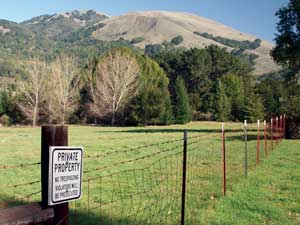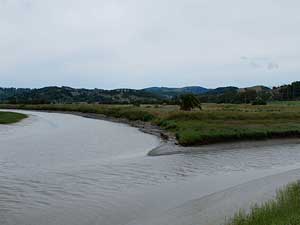| Marin Conservation League | 175 N. Redwood Dr., Ste. 135 | San Rafael CA 94903 | Tel 415.485.6257 | Fax 415.485.6259 Email Us. |
 |
ENews Article 7
Status updates
Local Coastal Plan | San Rafael Sports Facility |Grady Ranch
Local Coastal Plan moves on to Supervisor hearings
The three-year process of amending the County’s Local Coastal Program (LCP) moved into its final rounds before the Board of Supervisors (BOS) with two workshops in March. Several hearings before the BOS will be scheduled next.
MCL supports the three-part mandate of the Coastal Act that calls for protection of sensitive coastal resources, protection of agricultural productivity, and enhancement of public access to the coast. With the understanding that a healthy ecosystem, including diverse habitats and clean water quality in Tomales Bay (pictured) and coastal streams is fundamental to sustainable and productive agriculture, MCL will continue to advocate for strong natural resource protections.
MCL continues to have concerns that the amended plan has weakened protections of streams and wetlands and their buffers and other environmentally sensitive resources on agricultural lands, compared to policies in the existing 1980-81 LCP.
To this end, MCL is in the process of reviewing the wording in the land use plan and development code that, together, make up the LCP, and proposing constructive recommendations for BOS consideration.
San Rafael Sports Facility
The San Rafael Planning Commission’s review of the merits of the now-renamed “San Rafael Sports Facility” at the San Rafael Airport site has been re-rescheduled for May 29. (Moved from May 15.)
In addition to concerns over the proximity of the project to Gallinas Creek (pictured) and its endangered species habitats, the public has raised questions concerning the basic safety of a large sports facility open to both adults and children situated so close to an airport runway. The California Department of Transpaortation Division of Aeronautics commented on the Negative Declaration for the project in 2006 and the Draft EIR in 2009. But in 2011, the California Airport Land Use Planning Handbook was updated, and new safety standards and regulations were set.
A recent letter dated March 9, 2012 from the Division of Aeronautics makes two important comments: first, that a group recreation facility, especially facilities used by children, in defined runway safety zones is generally prohibited by land use guidelines; and second, that vehicles taller than five feet in the parking row closest to the runway would be considered an obstruction to air navigation.
On the first issue: Although the land use guidelines do not apply specifically to private airports, they could be viewed as setting a de facto threshold of significance under CEQA, in which case those areas of the proposed facility that lie within designated safety zones would raise the potential for “significant” impact on safety of users of the facility. Such an interpretation constitutes “new information” requiring a revised EIR.
On the second issue: A review of the proposed parking layout reveals that substantial portions of the parking lot, turnaround and auxiliary parking lot would need to be configured to avoid the chance for trucks or other vehicles greater than 5 feet tall to become obstructions to air navigation, in violation of the regulations.
Given the City of San Rafael’s potential liability in placing the facility in a hazardous area, or of allowing unsafe obstructions to air navigation in parking areas, city staff delayed further hearings until this information could be analyzed as to its implications on the FEIR process and on the merits of the project.

Grady Ranch
On April 10, Lucasfilm announced its intention to drop the Grady Ranch project and to put the land up for sale. The stated reason was neighborhood opposition and the threat of legal challenge that could further delay the project.
A brief synopsis may clear up misconceptions that followed the announcement. On February 27, 2012, the Planning Commission recommended certifying the Final Supplemental Environmental Impact Report (FSEIR) and approved the development plan. The Lucas Valley Estates Homeowners’ Association (appellants) filed an appeal on the grounds that the FSEIR violated CEQA in several respects. On April 3, the Board of Supervisors (BOS) heard the appeal but deferred a decision pending legal review of new information the appellant’s attorney had brought to light that could affect the legal adequacy of the FSEIR. One week later Lucasfilm announced dropping the project.
The “new information” referenced above is critical to an understanding of the issues. Unknown to County Staff and Planning Commission, state and federal agencies charged by law with permitting a key element of the Grady Ranch project—namely, the restoration of Miller Creek and tributaries—had received a permit application from Lucas’ engineers in August 2011 for the proposed restoration plan.
After careful analysis, the agencies determined that it could not be permitted as designed. The plan to raise the deeply incised creek bed by filling it with 68,000 cubic yards of rock and dirt excavated for the building (one-quarter of the total) carried unacceptable risks to downstream water quality and aquatic resources and, therefore, would have to be revised. This contradicted the FSEIR, which identified possible risks of the plan but concluded that they were not significant.
In his research, the appellants’ attorney found that the agencies had submitted a detailed critique to the Lucas consulting team (Memorandum, December 8, 2011), and, unknown to County staff, revisions to the restoration plan were in progress. As a consequence, the Planning Commission approved both SFEIR and Precise Development Plan in late February without knowing that the project was being revised and that potential new impacts might have to be addressed, such as disposing of 68,000 cubic yards of now-excess material from excavation. It is unfortunate that neither Lucas’ engineers nor agencies apprised the County in a timely manner of project revisions that could affect conclusions in the FSEIR.
New information that contradicts conclusions in a Final EIR before it is certified, or raises new, potentially significant impacts, typically requires that the document be revised and possibly even recirculated. This was the basic request made in the neighbors’ appeal. With limited advance notice of these issues, the BOS on April 3 properly postponed a decision on the appeal to allow legal review to determine the need to revise the FSEIR. Citing delays and neighborhood opposition, the applicant announced his intent to withdraw the project a week later. In reality, the satisfactory revision to the creek restoration plan and CEQA compliance could likely have been resolved to the neighbors’ satisfaction within a few months’ time.
Back to top



